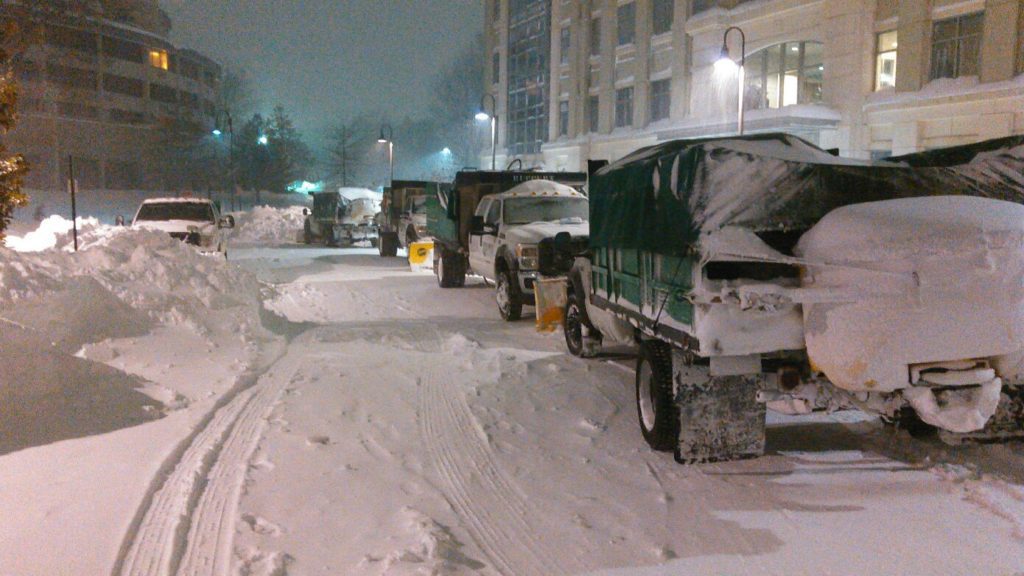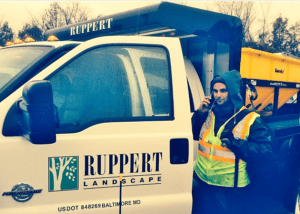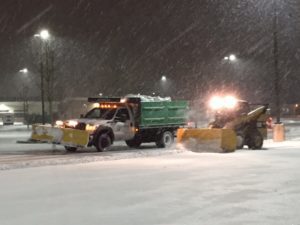By Dave Sanders, Director of Safety and Risk
 As winter approaches, we naturally find ourselves preparing for the weather to come—dressing in layers, turning the thermostat up in our house, and making sure our vehicles are in good working order. In our line of work, winter weather brings big opportunities but also many hazards that we must be prepared for. Prior to the first snow event of the winter, proper training is essential for safe operations. We take a number of precautions and instruct our snow removal crews on proper safety procedures.
As winter approaches, we naturally find ourselves preparing for the weather to come—dressing in layers, turning the thermostat up in our house, and making sure our vehicles are in good working order. In our line of work, winter weather brings big opportunities but also many hazards that we must be prepared for. Prior to the first snow event of the winter, proper training is essential for safe operations. We take a number of precautions and instruct our snow removal crews on proper safety procedures.
The Right Gear
Our crews come face to face with some of the worst wind, snow and ice conditions, which means we need to stay warm and do what we can to increase visibility for our safety and that of others. Personal protective equipment (PPE) may include:
 safety vest
safety vest- safety glasses
- hearing protection
- jacket and coveralls
- boots
- gloves
- winter hat
Safe Vehicle and Equipment Operation
Safe driving and proper vehicle operation can prevent countless accidents before they occur, so it is always important to remember these practical rules for the road when driving to and from work as well as plowing and applying ice melt:
 Always wear a seatbelt. They reduce the number of fatal injuries in accidents and provide a secure hold if you lose control of your vehicle.
Always wear a seatbelt. They reduce the number of fatal injuries in accidents and provide a secure hold if you lose control of your vehicle.- Mounting and dismounting. Winter weather and ice melting materials can make vehicle and equipment surfaces very slippery. Always use three points of contact when getting onto, into, or off of vehicles and equipment.
- Obey traffic laws. Watch the speed of your vehicle as it could quickly lose traction on icy, snow-covered roads.
- Beware of distracted driving. Never use your cellular device while driving company or personal vehicles and always be aware of what is happening on the road around you.
- Know the safe backing rules. Always do a circle check, back slowly and cautiously, and use a spotter or plan your work to avoid backing when possible.
- Drive defensively. Be on the lookout for other vehicles and pedestrians especially when visibility is low.
- Fatigue is a factor. Long hours of plowing and spreading can be exhausting.
- Know your limits and don’t drive when you’re too tired to stay focused.
Handling Materials
 Working with abrasive materials such as salt and other ice melt products doesn’t need to be a hazard. Know what products to use for your situation and site and how to apply it for the best result. Know what you are handling and follow recommendations for proper personal protective equipment. Refer to the safety data sheet for each product for precautionary measures, recommended PPE, and emergency procedures in case of spill or exposure.
Working with abrasive materials such as salt and other ice melt products doesn’t need to be a hazard. Know what products to use for your situation and site and how to apply it for the best result. Know what you are handling and follow recommendations for proper personal protective equipment. Refer to the safety data sheet for each product for precautionary measures, recommended PPE, and emergency procedures in case of spill or exposure.
When employees are well-trained and safety is at the forefront, our operations will be more efficient, making the winter months a better experience not only for us, but for our clients as well. The worst time to do snow training is on the fly or when you’re already behind the wheel in a storm. It’s always best to have a plan and prevent snow-related accidents ahead of time. Remember, the best way to handle winter weather is prepare, prepare, prepare!
 safety vest
safety vest Always wear a seatbelt. They reduce the number of fatal injuries in accidents and provide a secure hold if you lose control of your vehicle.
Always wear a seatbelt. They reduce the number of fatal injuries in accidents and provide a secure hold if you lose control of your vehicle.